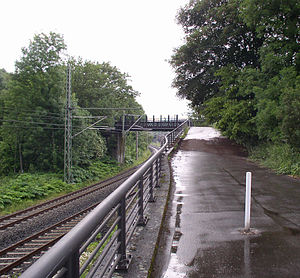Dog bridge
Coordinates: 51 ° 23 ′ 2 " N , 7 ° 6 ′ 41" E
| Dog bridge | ||
|---|---|---|
| Dog bridge | ||
| Official name | Dog bridge | |
| Convicted | formerly the Lorenbahn, today a footpath and bike path | |
| Subjugated | Deilbach and the Wuppertal-Vohwinkel – Essen-Überruhr railway line | |
| place | Essen , Byfang / copper turning | |
| construction | Arch and iron truss bridge | |
| completion | 1880 | |
| location | ||
|
|
||
| Above sea level | 74 m | |
The dog bridge is a listed arched and iron truss bridge over the Deilbach and the railway line Wuppertal-Vohwinkel-Essen-Überruhr between the Essen districts of Byfang and Kupferdreh . It is part of the Deilbachtal museum landscape and is a location on the Route of Industrial Culture . Today the dog bridge serves as a cycle and footpath. The former route of the Prince Wilhelm Railway is now part of the S-Bahn line 9 , between Wuppertal and Borken. The steel structure of the bridge was lifted and restored in the 1990s to expand the railway line as an S-Bahn.
history
The bridge was built in 1880 by the quarry operator Hermann Baumotte and in the course of the establishment of the Victoria colliery . While the bridge over the Deilbach was built as a three-arch bridge made of quarry stone masonry made of Ruhr sandstone , the subsequent bridge over the tracks of the Prince Wilhelm Railway, which opened in 1830, was carried out as an iron truss bridge. The narrow bridge connected the Vossnacker Weg quarry with the railway via a wagon train.
function
The bridge was primarily used to load the stones onto the railroad. The descent ran parallel to the railway line (see photo) and served as a loading ramp. From here the stones from the dogs were tipped into the railroad cars.
The name
The name Hundebrücke is derived from the wagons of the Lorenbahn that runs above it . These wagons, usually called " lorries ", were called "dogs" in the Ruhr area. These coal dogs originally came from mining. They had a very narrow wheelbase so that they could be maneuvered in tight corners and could be quickly levered back onto the rails in the event of derailments. During the journey, however, the wagons wobbled back and forth, like a running dog. The term Hunten is occasionally used, but it is just an old spelling for "dogs".
literature
- Johann Rainer Busch, The historic Deilbachtal in Oberbyfang and Kupferdreh, an inventory . Essen 2013
Web links
- Description of all locations on this themed route as part of the Route of Industrial Culture
- Excerpt from the list of monuments of the city of Essen (PDF; 579 kB); Retrieved November 9, 2016
- Dog bridge. In: Structurae

